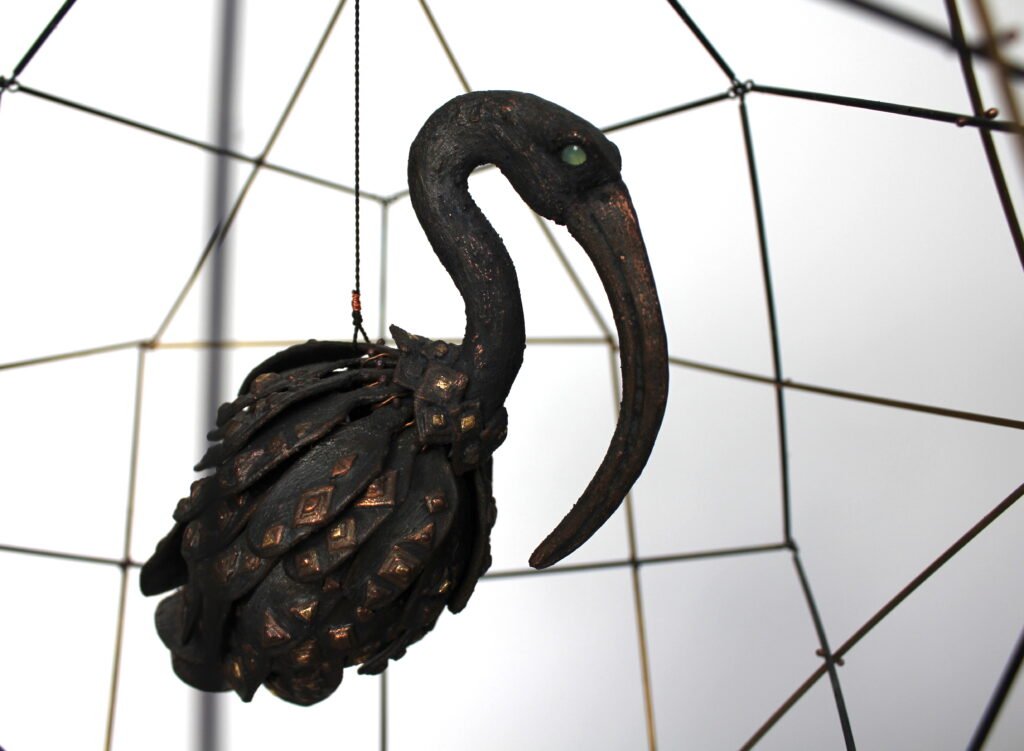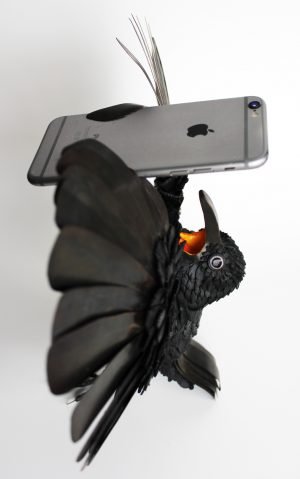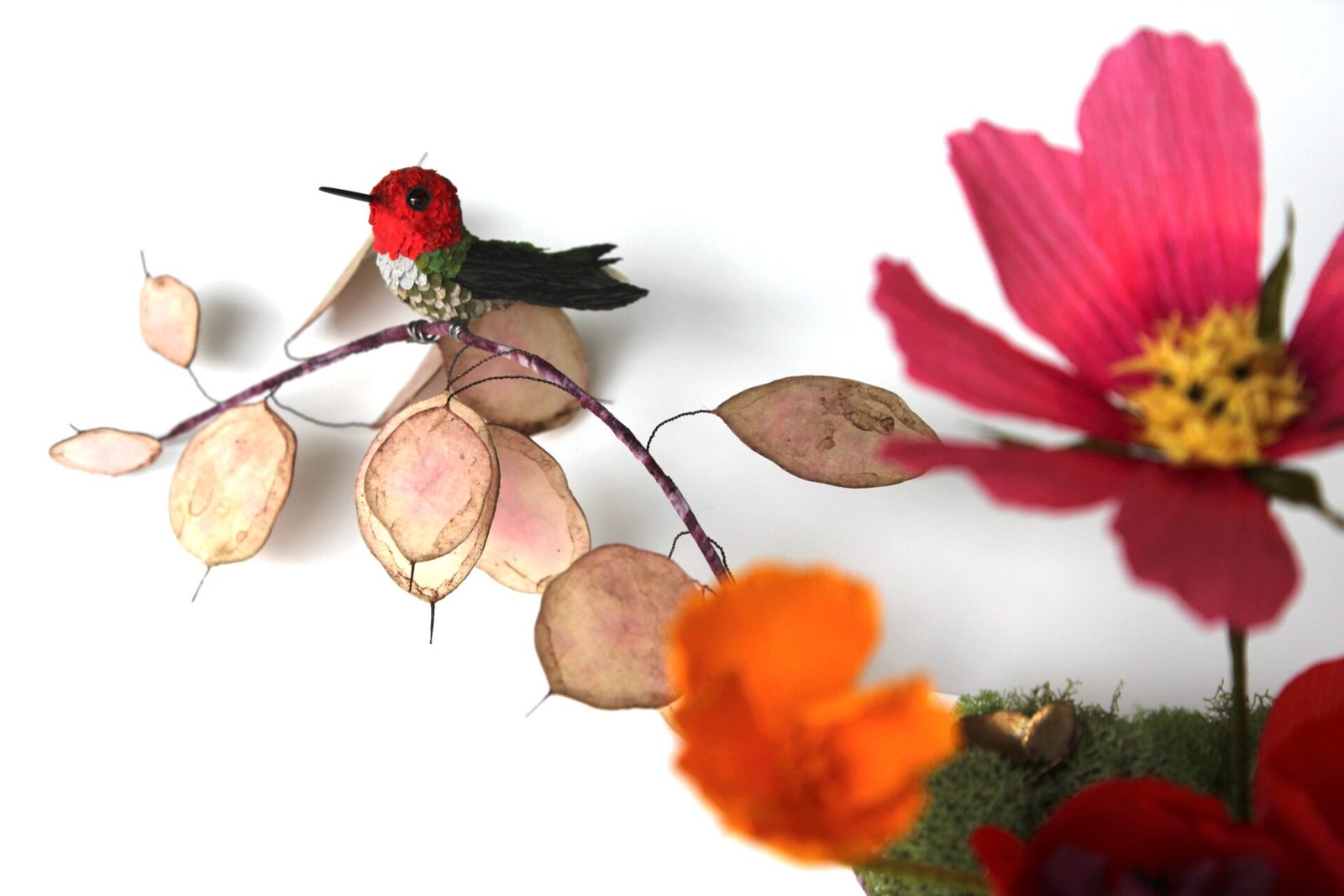
belonging
belonging
fia cooper
on view in gallery: october 1 – november 12, 2020
Fia Cooper
be•long•ing
1: close or intimate relationship; an affinity for a place or situation
2: possession; something owned, occupied, or controlled
Exploring the relationship of the material and immaterial in objects and individuals, with an ornithological appreciation

Belonging is a series of sculptures exploring themes of attachment, significance and influence. The desire to belong is universal, arguably the basis of existence and central to survival. Attachment is the principle at the core of this, as themes of allegiance and ownership play out constantly in the world around us.
Made primarily with metalworking techniques paired with mixed media, birds and bird-related objects are incorporated into works that reflect stages of attachment. Bird species perform as proxy for the human dynamic, suggesting that we are not alone in our need to connect and belong.
Fia Cooper is a custom metalwork designer and jewelry artist living and working in the Sunshine Coast, British Columbia. She attended Kootenay School of the Arts in Nelson BC, majoring in metal and studying jewelry. Furthering her education, Fia has worked in the fields of bronze casting, blacksmithing, and custom fabrication. Her work is created with curiosity and a playful regard for the patterns and geometries that surround and shape us.

When Fia Cooper first started this body of work there were two distinct influences at play: the work of Gordon Neufeld (PhD), a developmental psychologist, and the work of Tim Laman and Ed Scholes, respectively, an ornithologist and wildlife photojournalist and an ornithologist with The Cornell Lab. Gordon Neufeld, founder of the Neufeld Institute, developed a theory of attachment, for the development of capacity for relationships, that includes six stages of attachment.
As a parent to a young child, Cooper found his work insightful and enlightening. These stages of attachment seemed to not only to apply to the developing mind, but also to those already formed. Cooper could see how early experiences of attachment played out and continued to influence behaviour in herself and others. Further, Cooper found it interesting to think about how the stages of attachment applied to situations and things outside of interpersonal relationships.
The six stages are sequential with each stage adding greater depth to a relationship. For children this translates to the ability to become separate, adaptive, and social beings. The six stages of attachment are as follows: proximity, sameness, belonging or loyalty, significance, love and being known.
The other influence informing Cooper’s most recent body of work is the documentation and study of the birds of paradise in the New Guinea region that was completed by Ed Scholes and Tim Laman. Cooper was blown away by their beauty and strangeness, creatures with unbelievable plumage and courtship displays doing things that she had never imagined birds doing. Having lived with birds, and understanding them to have unique and individual personalities with social needs, Cooper started imagining what some of our human behaviours would look like if they were coming from a bird. How might that perspective change how we see ourselves?
Since starting this body of work the world has shifted dramatically. More than ever, how we show up in the world around us matters. Technology has connected us in ways that were unimaginable not so long ago. As the world becomes more divided it is worth considering what holds us together; how are we are attached.
the -Ship, 2020
emergency blanket, steel, copper, yupo paper, ink, pastel
Etymology is fascinating in how it connects us to our origins. The word companion derives from the Latin ’com’ (with) + ‘panis’ (bread). The root meaning of the word is ‘one that you eat or break bread with’. Adding the suffix -ship to the word changes the meaning; companion-ship speaks to the state, or condition between the companions, and functions likewise for all sorts of words… craftsman… citizen… relation… friend…
The -ship is immaterial, a quality of attachment, held in place by will. Our closest connections are still delicate feats of engineering.
When we take these connections for granted, feeling entitled to them or that they’re something we own, we miss the boat. The -ship capsizes… abandon-ship… a ghost- ship adrift.
The -ship sails for those who know the ropes. It offers safe passage to those who are onboard to weather the storms, chart past voyages, and navigate new territories. Giving shelter to the ones that orient to the shifting seas
“…Ah, love, let us be true
To one another! for the world, which seems
To lie before us like a land of dreams,
So various, so beautiful, so new,
Hath really neither joy, nor love, nor light,
Nor certitude, nor peace, nor help for pain;
And we are here as on a darkling plain
Swept with confused alarms of struggle and flight,
Where ignorant armies clash by night.”
(Arnold, Mathew. Dover Beach. 1867)
Caged Ibis (2018)
electro formed thermoplastic, chrysoprase, silver, gold, silk and steel
Memories are dark matter. A presence that is implied more than palpable,
and impossible to see directly. Observable only by the powerful effects they
have. As we shape our memories, our memories in turn shape our present.
Each time we remember we recreate that memory, and change it. The present
and past collide. The present and our perception of the past are dual. One
creates the other, and in so doing, together create something new.
In the same way, this idea of duality is found in geometry. The shape of the
cage around the Ibis is called an Archimedean dual. The black lines form a
dodecahedron, and the gold ones form a cuboctahedron. The dodecahedron
arises from dualizing the cuboctahedron – meaning that if you were to mark
a point in the middle of each face of the cuboctahedron, and connect those
points by lines, you would draw the edges of a dodecahedron. Each shape
creates its own space, and when combined form something distinctive.
Ensnared, 2020
bronze, paper, ball vice, fly fishing supplies; wool, wire, silk floss, thread and tinsel
There is a dark side to our relationship with material objects and you don’t need to look far to find it. The trappings of success can be an obsessive lure, ensnaring not only the people who possess them, but also innocent occupants of pretty feathers and fur… not to mention fish. One example of this is the resurgence of the Victorian art of salmon fly- tying. In his book The Feather Thief, Kirk Wallace Johnson chronicles the bizarre true crime tale of the natural history heist of the century, and illustrates what it is to be completely overcome with possessing objects of beauty
“…his analytical diagram of the fly reveals 19 different components, to say nothing of the various styles and curvatures of hook. To tie like Kelson his readers would need a silver monkey, a Gray squirrel, pigs wool, silk from the Orient, fur from the Arctic, a hares face and a goats beard…The Durham Ranger introduced in the 1840s by Mr. William Henderson of Durham England, demanded the crest feathers of the Golden pheasant from the Mountain forests of China. Black and fiery orange breast feathers from the red ruffed fruit crow, known to fly tiers as Indian Crow of South America. Ribbon like filaments of ostrich herl feathers from South Africa, and tiny turquoise plumes from the blue chatterer of the lowlands of Central America. The fly was like a snapshot of the British Empire at mid Century, employing plumes shipped up by ostrich farmers in the Cape colony, blue chatterer and Indian crow extracted from British Ghana, and golden pheasant crated in the Port of Hong Kong….” (Wallace Johnson, Kirk. The Feather Thief. Random House, 2018)
Tender, 2020
international currencies, copper, graphite, epoxy, yupo paper, found objects, digital collage, iPad
This piece is based on the Satin Bower bird. These fascinating birds build complex bowers to attract mates. The males of the species build the bowers, collecting shiny and colourful objects, usually blue, to decorate with and entice the females. In the first seven years the juvenile males look identical to the females. They go around visiting bowers, being wooed by other males and learning how to to do it all themselves when the time comes. Typically the female of the species chooses a mate based on aesthetics and the quality of the courtship display. This is known as sexual selection and is different from natural selection. Overtime this changes the birds genetics to favour the biological qualities that the females prefer, which are not necessarily the qualities that benefit the species as a whole.
Our courtship rituals are now digital. In the past ‘putting yourself out there’ meant vulnerability, spontaneity, excitement and a sense of risk. Now it seems to come with filters, face tuning, spell check, the delete button, feigned indifference, and limitless choices. Tinder asks you for ‘the best picture of yourself’ when you sign up for an account. What do these photos say about a person? Aspirational phrases centred around self worth; things like ‘live the best version of yourself’ are now standard messages on social media, and imply that there are many versions, some better than others, and only one that is worth living. Is it self worth… self modification… self commodification?
As we curate our online identities, we present a hybrid of who we think we are and how we’d like to be perceived. It is inherently self promoting. We are both celebrating and selling our ego. The Internet is changing us. It amplifies the power we have to choose how we focus our attention, but it also leads us down rabbit holes.
iObject, 2019
rubber, copper, epoxy, paint, photography, iPhone hardware
I + Object, for example me and my keys or phone. Common items that I use and rely on on a daily basis. Separate from me but fairly vital as I go throughout my day.
iObject, on June 29, 2007 Apple released the first iPhone. A name that suggests a merging of the individual with the handy device that is the iPhone. For many people it’s the first thing they touch when they wake up in the morning and the last thing before they go to bed, spending hours in between staring at it’s thin screen.
I object, a decade after the introduction of the modern smart phone, death by selfie became a cause of death, surpassing shark attacks by the year 2015. At this point, a little over a decade after its inception, much of the planet is using hand held electronic devices. The tool shapes the hand. For better or worse the use of technology and social media shapes and changes us, but it
can be hard to see those changes happening when we are consumed by our own image and identity within it.
The bird in this piece is based on a Victorian Riffle bird. The males have spectacular courtship displays to entice the females of the species. But the bird, instead of directly interacting with another bird is absorbed in it’s own image. It’s easy to see this behaviour as ridiculous in another species but what about in our own?
Oology, 2020
silk, bronze, grass, copper
A little egg
Found like a treasure In the moss
Under a tree
Perfect and whole
Pale blue and jewel like
Precious and delicate
Fragile
A small piece of wonder Filled with grace
And cold
Gone from it’s nest
Never more to break free
And fly away
Caged Ibis (2018)
electro formed thermoplastic, chrysoprase, silver, gold, silk and steel
Memories are dark matter. A presence that is implied more than palpable, and impossible to see directly. Observable only by the powerful effects they have. As we shape our memories, our memories in turn shape our present. Each time we remember we recreate that memory, and change it. The present and past collide. The present and our perception of the past are dual. One creates the other, and in so doing, together create something new.
In the same way, this idea of duality is found in geometry. The shape of the cage around the Ibis is called an Archimedean dual. The black lines form a dodecahedron, and the gold ones form a cuboctahedron. The dodecahedron arises from dualizing the cuboctahedron – meaning that if you were to mark a point in the middle of each face of the cuboctahedron, and connect those
points by lines, you would draw the edges of a dodecahedron. Each shape creates its own space, and when combined form something distinctive.

